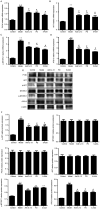Pulsatilla decoction alleviates colitis by enhancing autophagy and regulating PI3K‑Akt‑mTORC1 signaling pathway
- PMID: 35103289
- PMCID: PMC8822884
- DOI: 10.3892/mmr.2022.12624
Pulsatilla decoction alleviates colitis by enhancing autophagy and regulating PI3K‑Akt‑mTORC1 signaling pathway
Abstract
The aim of the present study was to investigate the therapeutic effect of Pulsatilla decoction (PD) on ulcerative colitis (UC) and to elucidate its potential molecular mechanisms. C57BL/6 mice expressing natural killer (NK)1.1 were used as experimental animals in the present study and a model of oxazolone‑induced colitis was established. Mice were randomly divided into the following five groups: i) PD group; ii) oxazolone‑induced colitis group; iii) IL‑13 intervention group; iv) 5‑aminosalicylic acid positive control group; and v) negative control group (equal volume saline gavage). A total of 10 animals were used in each group. The effects of PD on UC and the association between this regimen and the PI3K‑Akt‑mTORC1 signaling pathway were evaluated by disease activity index (DAI), hematoxylin and eosin staining, reverse transcription‑quantitative PCR (RT‑qPCR), immunofluorescence assay, ELISA and western blotting. The UC models were successfully established by injecting oxazolone gavage solution. Clinical colitis evaluation and histological examination revealed that PD reduced the DAI values in oxazolone‑induced colitis in mice and the degree of infiltration in NK1.1 cells. PD significantly reduced the secretion of IL‑13, as determined using an ELISA. In addition, western blotting and RT‑qPCR analyses demonstrated that Beclin1 and LC3II/I expression levels were downregulated following treatment of the mice with PD. In addition, PD not only partially restored alterations in the expression of tight junction proteins in the colon tissues, but also suppressed the activation of the PI3K‑Akt‑mTORC1 signaling pathway. The data indicated that this regimen could alleviate oxazolone‑induced UC in mice, which could significantly reduce tissue inflammation and autophagy. The mechanism of action was associated with the PI3K‑Akt‑mTORC1 signaling pathway.
Keywords: PI3K‑Akt‑mTORC1; Pulsatilla decoction; autophagy; ulcerative colitis.
Conflict of interest statement
The authors declare that they have no competing interests.
Figures







References
-
- Ko CW, Singh S, Feuerstein JD, Falck-Ytter C, Falck-Ytter Y, Cross RK, American Gastroenterological Association Institute Clinical Guidelines Committee AGA Clinical practice guidelines on the management of Mild-to-Moderate ulcerative colitis. Gastroenterology. 2019;156:748–764. doi: 10.1053/j.gastro.2018.12.009. - DOI - PMC - PubMed
Publication types
MeSH terms
Substances
LinkOut - more resources
Full Text Sources
Medical

